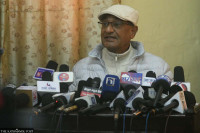National
As pollution peaks, unsafe air could have detrimental effects on athletes
With over 6,000 athletes and officials arriving for the South Asian Games, concerns about Kathmandu’s air pollution are very appropriate, environmentalists say..jpg&w=900&height=601)
Chandan Kumar Mandal
After two decades, the South Asian Games has returned to Nepal with three cities—Kathmandu, Pokhara and Janakpur—witnessing rapid makeovers to welcome over 6,000 athletes and officials from seven countries for the 10-day multi-disciplinary event. With the Games beginning on Sunday, everything is all set—except for the air.
In the 20 years since the games were last held in Nepal, a lot has changed in Kathmandu—the capital city that will be hosting a majority of events. Rampant construction, along with an exponential increase in vehicles, has meant that Kathmandu consistently ranks among the most polluted cities of the world.
According to AQ AirVisual, a Swiss group that collects air-quality data from around the world, the annual average count for PM 2.5, the most dangerous particulate matter in the air, has been in “unhealthy” category for sensitive groups since 2017. PM2.5 levels rise even higher during the winter months of November, December and January.
With so many athletes in Kathmandu for the Games, the air pollution levels are a significant concern, especially since they tend to train in the mornings and evenings, when pollution is often at its highest, say environmentalists.
According to Bhushan Tuladhar, an environmentalist who closely follows urban environmental issues, no thought has been given to improving the city’s air quality while preparing to host the sporting event.
“The timing of the event collides with the deteriorating quality of the air. It’s not that we should postpone the event, but no one even thought about air pollution,” Tuladhar told the Post. “Nothing seems to have been done to improve air quality.”
While the government has introduced odd-even rules for vehicles for the inaugural and closing days of the event, it has more to do with facilitating the movement of VIPs, rather than controlling air pollution, said Tuladhar.
As the winter sets in, air quality in major cities, including the capital, turns unsafe as there is no wind and pollutants tend to sink to the surface with the morning dew. Various studies have shown that outdoor activities should be avoided.
“We witness a rise in cases of pneumonia and Chronic Obstructive Pulmonary Disease (COPD) in hospitals at this time of the year,” said Meghnath Dhimal, chief research officer at the government's Nepal Health Research Council. “Morning and evening time has peak air pollution levels so outdoor activities at this time should be avoided.”
However, Dhimal doesn’t think there is reason for visiting sportspersons and officials to panic.
“Our pollution levels are still relatively lower than in other South Asian countries, as we have not yet reached unhealthy levels. Also, most games will be in the afternoon when air pollution levels are comparatively lower,” said Dhimal.
According to Dhimal, the pollution in Kathmandu is mostly due to dust, unlike industrial pollution, which emits harmful chemicals in the air.
Air pollution has increasingly become a major concern for cities across the world, taking its toll on major sporting and entertainment events. Air pollution’s impact on sports was a cause for concern as far back as 1984, during the Olympic Games in Los Angeles, which was clouded in smog. Steve Ovett, a former track athlete from England, collapsed with respiratory problems after the 800 metres final, citing air pollution as a major trigger for his exercise-induced asthma.
The 2008 Beijing Olympics earned the infamous tag of the “most polluted games ever” as athletes were seen wearing face masks while some countries made arrangements for their players to train in neighbouring nations and only arrive in Beijing for the opening ceremony.
Irrespective of air quality and the nature of the games, the health consequences of poor air quality remain a concern for players, especially those participating in athletics events, according to Tuladhar.
“Marathon runners need to inhale more air. Unlike sprint runners, marathon runners are exposed to bad air for at least two hours, as they also run along the main roads,” said Tuladhar. “Poor quality of air can have an effect on their stamina and performance. Even indoor games players breathe the same polluted air, although it might be worse along the main streets.”
The 13th edition of the Games will feature 26 events, most played indoors. However, games like football, cricket, beach volleyball, cycling, and athletics events will be performed outside.
According to Bikram Neupane, a physiotherapist with the Nepali national cricket team, environmental pollution like poor air can lead to breathing problems and various allergies for players on the field.
“Not every player has the same level of immunity and cannot deal with pollution in the same manner,” said Neupane. “We cannot see pollutants with the naked eye but they are there all the time.”
Cricket has returned to the Games after a gap of eight years. Nepal will be playing its first match against Sri Lanka on December 3 and Neupane worries that pollution will play its part in the players’ performance.
“Air pollution definitely affects players’ performance. As they are inhaling poor quality oxygen, they can get tired early,” said Neupane. “The morale of the same players is higher when they play in countries with clean environments.”
According to Neupane, various studies have shown that air pollution can have a detrimental effect on players’ performance.
In 2017, a cricket match between India and Sri Lanka hosted in Delhi made headlines when Sri Lankan players fell ill, as air pollution exceeded the World Health Organisation’s ‘safe limit’ by 12 times because of the notorious ‘Delhi smog’. Sri Lankan players donning face masks led the Indian cricket authority to consider pollution level as a deciding factor before fixing future matches.
A separate study, which analysed soccer players in the German Bundesliga and hourly information on the concentration of particulate matter in spatial proximity to the stadium at the hour of kickoff, concluded that the concentration of particulate matter has a negative effect on players’ productivity.
In this regard, the location of Dashrath Stadium, which is hosting a majority of events, at the centre of the city with massive vehicular movement is significant.
“Although Nepali athletes have not been able to practise on the home track because of delays in preparation, air pollution will not have a significant impact,” said chief coach Chandra Gurung. “Other countries also have similar levels of pollution. It might have a small effect but is unlikely to affect their performance. These are young and well-trained athletes. Air pollution mostly affects the elderly and sick.”
Sports has significant health benefits but only when conducted in environments where the air quality is safe. These same sports, which are physically draining, can be counterproductive if played under unsafe levels of pollution.
In order to tackle pollution, Tuladhar suggests that vehicular movement can be diverted away from major sporting arenas and the marathon track.
“If they really wanted to control the air pollution, they could have simply repaired the service lanes of the main streets,” said Neupane. “We all know dust from the roads is one of the major sources of pollution in the country.”




 12.12°C Kathmandu
12.12°C Kathmandu













%20(1).jpg&w=300&height=200)

